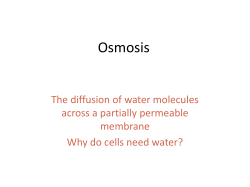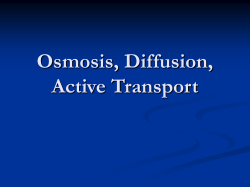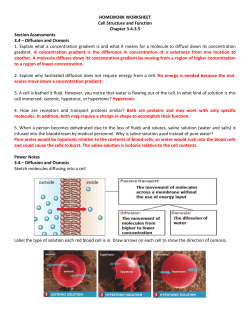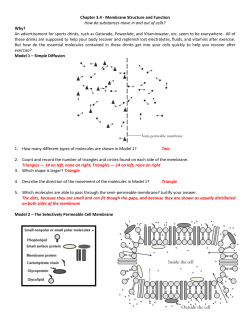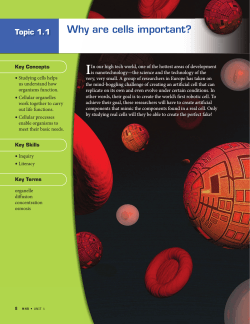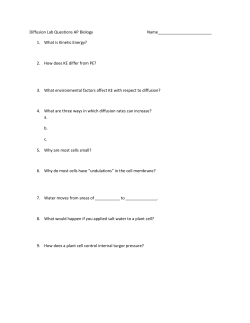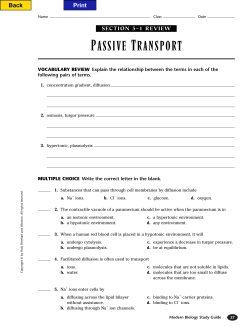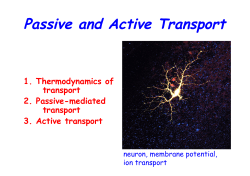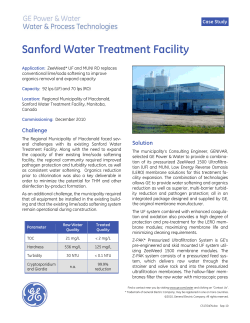
CHAPTER 2 PASSIVE TRANSPORT
CHAPTER 2 “GETTING IN & OUT OF CELLS” PASSIVE TRANSPORT Cell membranes help organisms maintain homeostasis by controlling what substances may enter or leave cells. Some substances can cross the cell membrane without any input of energy by the cell. The movement of such substances across the membrane is known as passive transport. 1. The activities of a cell depend on the materials that enter and leave the cell. 2. To stay alive, a cell must exchange materials such as food, oxygen and waste with its surroundings. 3. These materials must cross the cell membrane. 4. Small molecules like water, oxygen and carbon dioxide can move in and out freely, since they can squeeze between the molecules of the membrane. 5. Large or charged molecules like proteins, sugars and ions cannot. 6. The cell membrane is thus said to be partially permeable. 7. A selectively permeable membrane only allows certain molecules to pass through. SIMPLE DIFFUSION 1. The simplest type of passive transport, diffusion does not require the cell to use energy. Only small molecules can cross the cell membrane by simple diffusion. 2. Diffusion is the movement of molecules from an area of high concentration to one of low concentration. 3. This difference in the concentration of molecules across a space is called the concentration gradient. 4. Diffusion is driven by the kinetic energy of the molecules. Because of their KE, molecules are in constant motion. Diffusion occurs when molecules move randomly away from each other in a liquid or gas. 5. The rate of diffusion depends on the temperature, size and the type of molecules that are diffusing. 6. Molecules diffuse faster at higher temperatures than at lower temperatures, and smaller molecules diffuse faster than large molecules. 7. Most transport of materials into and out of cells occurs by diffusion. 8. The concentration gradient is the difference between the concentration of a solute in one place and its concentration in an adjacent area. 9. Remember: Fick’s Law, i.e. Diffusion α surface area x concentration difference distance 10. Diffusion always occurs down a concentration gradient, i.e. from the area of higher concentration to the area of lower concentration. 11. When molecules are dispersed evenly, there is no longer any diffusion because there is no longer a concentration gradient. 12. Diffusion will eventually cause the concentration of molecules to be the same throughout the space the molecules occupy, when they will be in equilibrium. OSMOSIS 1. Osmosis is “The process by which water molecules diffuse across a partially permeable membrane from a region of higher water potential to a region of lower water potential.” 2. The symbol for water potential is the Greek letter Ψ (psi) or Ψw. 3. Water moves by diffusion, like any other molecule, from a region of high concentration to one of low concentration, i.e. down its concentration gradient. Confusion occurs because ‘concentration’ normally refers to the solute concentration, whereas, in this case, we are referring to the solvent concentration. 4. For this reason, the use of the term ‘water potential’ is essential; water then simply moves ‘down the water potential gradient’ – easy! 5. The water potential of pure water is zero (0), so, since a solution must always be less than 100% pure water, all solutions (and cells) have a negative (-) water potential. 6. The strength of a solution is given by its solute potential (Ψs). The stronger the solution, the more negative this value will be. 7. One large and one small molecule will both have the same osmotic effect (i.e. lower Ψs by the same amount). So, a single molecule of protein will have about 100 times less effect than the individual amino-acid molecules that make it up. 8. Insoluble molecules do not affect the solute potential (obviously), so have no osmotic effect. Such molecules are used for storage – starch, lipids, and very large proteins (albumin). 9. Water potential is actually a pressure, and is measured in Pascals (Pa), but since these are so small the normal unit is the kilo Pascal (kPa). Typical plant values are -200 to -2000kPa. 10. Plants have a cell wall which normally presses on the cell membrane, giving us the pressure potential (Ψp). Since this opposes the tendency of the cell to expand due to osmosis, it therefore follows that the pressure potential (Ψp) is always positive. 11. Since animals have no cell wall, and so no pressure potential, the solute potential and the water potential must be the same: (Ψw) = (Ψp) 12. Similar logic shows that the water potential of every cell in an animals’ body must be the same, since they are all in contact with blood, and thus in equilibrium (‘two values that are equal to a third value, must be equal to each other’) 13. When a plant cell is turgid (its normal state), the net movement of water into and out of the cell is zero. Thus: (Ψw) = (Ψs) + (Ψp) 14. Note that calculations on this will not be set in the exam. 15. The net direction of osmosis depends on the relative concentration of solutes on the two sides of the cell membrane. 16. In a hypertonic solution, the concentration of solutes in the solution is higher and so it has a lower (i.e. more negative) water potential (Ψw). Therefore, when placed in a hypertonic solution, water leaves the cell by osmosis, until equilibrium is established. 17. If the cell loses too much water, the cell will shrivel and shrink. Eventually they die, as their metabolism is disrupted i.e. badly wilted plants never recover fully. 18. Conversely, cells in a hypotonic (or weaker) solution will absorb water by osmosis until equilibrium is reached, since the cell has the lower water potential, and water ‘flows downhill’. 19. This flow of water into a cell causes it to swell: a. Animal cells placed in a hypotonic solution will swell and often burst because of osmosis. N.B. The bursting of cells is called cytolysis. b. Plant, fungal and bacterial cells do not burst because of their cell wall. The pressure that the cell exerts against the cell wall is its pressure potential Ψp. These cells are normally in this state, i.e. turgid. 20. In an isotonic solution, the concentration of solutes on both sides of the membrane is the same and so the net movement of water is zero. This is the normal position inside an animal’s body. HOW CELLS DEAL WITH OSMOSIS 1. Cells that are exposed to an isotonic environment have no difficulty keeping the movement of water across the cell membrane in balance. This includes all land and most marine animals. 2. However, cells functioning in a hypotonic environment, such as Protoctista living in fresh water have a problem, as water will constantly enter them, down the water potential gradient, from their surroundings. 3. Since they cannot lower their water potential to near-zero, such organisms must rid themselves of the excess water. 4. Some (e.g. Paramecium –see left) have contractile vacuoles, which actively pump water out of the cell. 5. This pumping action requires energy – so is a form of active transport. Up to 30% of the cell’s energy may be used in this way. 6. Plant root cells also live in hypotonic environment, so water (only!) normally moves by osmosis into the root hair cells, until they are turgid. Water then moves from these cells into the xylem down the water potential gradient (see Module 5 notes!) 7. In a hypertonic environment, water leaves the cells by osmosis, the cell membrane shrinks away from the cell wall, and turgor is lost. This condition is called plasmolysis, and is the reason plants wilt. The effect of osmosis in: a) hypertonic solution b) isotonic solution c) hypotonic solution. FACILITATED DIFFUSION 1. Passive transport across a membrane requires no energy input from the cell and always goes down the concentration gradient. Simple diffusion and osmosis are examples of passive transport. 2. However, most molecules cannot cross the membrane by simple diffusion; to do so, the molecule must either be very small (H2O, CO2) or be soluble in both water and lipid (ethanol). 3. Some molecules are carried across the membrane by carrier proteins which are embedded in the cell membrane. 4. Carrier proteins often change shape when molecules attach to them, and this change in shape enables the molecule to cross the membrane. 5. Because the carrier protein has to fit around the molecule, it is specific to one molecule, or related class of molecules. 6. This use of carrier proteins to cross the membrane is known as facilitated diffusion, and can be used by those molecules to cross the membrane in either direction – into or out of the cell. 7. Like simple diffusion, facilitated diffusion always goes down the concentration gradient, and therefore continues until equilibrium is reached, for that molecule (see below) 8. A good example of facilitated diffusion is the transport of glucose into the cell. Once inside the cell, the glucose is immediately turned into glucose phosphate, for which no carrier protein exists. Glucose will thus continue to enter the cell, since equilibrium can never be reached! 9. Facilitated diffusion is therefore another form of passive transport, since it requires no energy input from the cell. 10. Some molecules, mainly ions (e.g. Na+, K+) cross the membrane through tunnels made of protein called ion channels. 11. Some ion channels are always open, but others (e.g. in neurones) have ‘gates’ that open to allow ions to pass or close to stop their passage. 12. Gates open and close in response to conditions in the external environment, or in the cell. It is the opening and closing of the sodium and potassium gates that allows a nerve impulse to be formed and passed along a neurone. ACTIVE TRANSPORT (using ATP energy) CELL MEMBRANE PUMPS 1. Cells often move molecules across the membrane against the concentration gradient, i.e. from an area of low concentration to an area of high concentration. 2. This requires energy (uses ATP), and is known as active transport. 3. Active transport involves the use of carrier proteins, similar to those of facilitated diffusion, but these carrier proteins act as pumps, using the energy from splitting ATP to pump specific molecules against the concentration gradient. 4. These carrier proteins are known as membrane pumps, and are particularly important in maintaining the Na+ /K+ ion balance between Eukaryotic cells and their external environment. 5. The sodium/potassium (Na+ /K+) pump maintains a high concentration of Na+ ions outside the cell, and a high concentration of K+ ions inside the cell. This is particularly important in muscle contractions, nerve impulses and the absorption of nutrients from the gut. 6. The Na+/K+ ion pump moves Na+ ions out of the cell, and K+ ions into the cell, against their concentration gradient, using ATP to supply the energy needed. 7. In plants, active transport enables roots to absorb mineral ions from the soil, which are therefore more concentrated inside plant cells than in the soil. 8. This requires ATP energy from aerobic respiration, and therefore roots need oxygen to allow mineral uptake and a waterlogged (thus anaerobic) soil will kill most roots. Summary of the different methods by which molecules can enter cells. BULK TRANSPORT (endocytosis and exocytosis) 1. Some molecules, such as large proteins, are too large to cross the cell membrane, and enter by bulk transport. Other examples include food particles and bacteria (phagocytes). 2. These are all packaged in membrane-bound sacs called b and moved across the membrane in this way. 3. Endocytosis means substances entering the cell; exocytosis means substances leaving the cell. 4. During endocytosis the cell membrane folds into a pouch that encloses the particles, before pinching itself off to form the vesicle. 5. The vesicle often then fuses with a lysosome, which releases its contents to digest the contents of the vesicle. 6. This is thus a form of cell feeding – called phagocytosis. When the particles absorbed are very small (e.g. proteins), it is referred to as pinocytosis, (or ‘cell drinking’). 8. White blood cells (WBC’s) known as phagocytes, destroy bacteria and other unwanted body cells by phagocytosis, including many millions of old RBC’s – broken down in the liver. 9. Exocytosis is the opposite of endocytosis and can be used for secretion (e.g. hormones, and enzymes, packaged in the Golgi apparatus) or for excretion of waste products (indigestible parts of food from Amoeba) © IHW September 2005
© Copyright 2025
